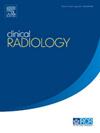Evaluation of shear wave elastography and B-mod ultrasonography of the achilles tendons in psoriasis patients without clinical diagnosis of psoriatic arthritis
IF 2.1
3区 医学
Q2 RADIOLOGY, NUCLEAR MEDICINE & MEDICAL IMAGING
引用次数: 0
Abstract
AIM
To investigate the utility of shear wave elastography (SWE) and conventional ultrasonography (B-mode and Power Doppler) (CUS) as imaging modalities to detect subclinical enthesopathy in early psoriatic arthritis (PsA).
MATERIALS AND METHODS
This study involved controls and patients with psoriasis who did not have a diagnosis of psoriatic arthritis. This study was conducted prospectively between January 2021 and June 2021 in a single centre. Age, gender, Psoriasis Area Severity Index (PASI) of the patients was recorded. CUS findings (thickness, contour change, hypoechoic heterogeneity, effusions, enthesophyte, bursitis, bone erosion, and increased tendon vascularity) of the Achilles tendons (ATs) were evaluated. Subsequently, SWE measurements in kilopascals (kPa) were conducted at the enthesis sites of the tendons.
RESULTS
The ATs of each of the 62 participants (31 patients and 31 controls) were evaluated. The mean age of the patients was 44.96 ± 17.44 years with a female dominance. The stiffness of the AT was significantly higher than the controls (p < 0.05). There were no statistically significant differences in AT thicknesses between the groups (p > 0.05). No significant correlation was found between the SWE of AT and PASI scores (p > 0.05, r = 0.1).
CONCLUSION
This study found that although CUS did not show any significant findings, the tendons of patients with psoriasis without musculoskeletal symptoms were statistically significantly stiffer according to SWE values compared to controls. These results suggest that SWE may be more effective than CUS in detecting subclinical enthesopathy and predicting the development of PsA in patients with psoriasis.
无临床诊断为银屑病关节炎的银屑病患者跟腱横波弹性成像及b超的评价
目的探讨横波弹性成像(SWE)和常规超声(b超和功率多普勒)(CUS)作为影像学检查早期银屑病关节炎(PsA)亚临床骨髓炎的应用价值。材料和方法本研究纳入对照组和未诊断为银屑病关节炎的银屑病患者。该研究于2021年1月至2021年6月在单个中心进行前瞻性研究。记录患者的年龄、性别、银屑病严重程度指数(PASI)。评估跟腱(ATs)的CUS表现(厚度、轮廓改变、低回声异质性、积液、内生真菌、滑囊炎、骨侵蚀和肌腱血管性增加)。随后,在肌腱末端进行千帕(kPa) SWE测量。结果对62例患者(31例患者和31例对照组)的ATs进行了评估。患者平均年龄44.96±17.44岁,女性居多。AT的刚度显著高于对照组(p <;0.05)。两组间AT厚度差异无统计学意义(p >;0.05)。AT的SWE与PASI评分之间无显著相关性(p >;0.05, r = 0.1)。结论本研究发现,虽然CUS未显示出明显的结果,但无肌肉骨骼症状的银屑病患者的肌腱根据SWE值与对照组相比,有统计学意义的更僵硬。这些结果提示SWE可能比CUS更有效地检测银屑病患者的亚临床终末期病变和预测PsA的发展。
本文章由计算机程序翻译,如有差异,请以英文原文为准。
求助全文
约1分钟内获得全文
求助全文
来源期刊

Clinical radiology
医学-核医学
CiteScore
4.70
自引率
3.80%
发文量
528
审稿时长
76 days
期刊介绍:
Clinical Radiology is published by Elsevier on behalf of The Royal College of Radiologists. Clinical Radiology is an International Journal bringing you original research, editorials and review articles on all aspects of diagnostic imaging, including:
• Computed tomography
• Magnetic resonance imaging
• Ultrasonography
• Digital radiology
• Interventional radiology
• Radiography
• Nuclear medicine
Papers on radiological protection, quality assurance, audit in radiology and matters relating to radiological training and education are also included. In addition, each issue contains correspondence, book reviews and notices of forthcoming events.
 求助内容:
求助内容: 应助结果提醒方式:
应助结果提醒方式:


